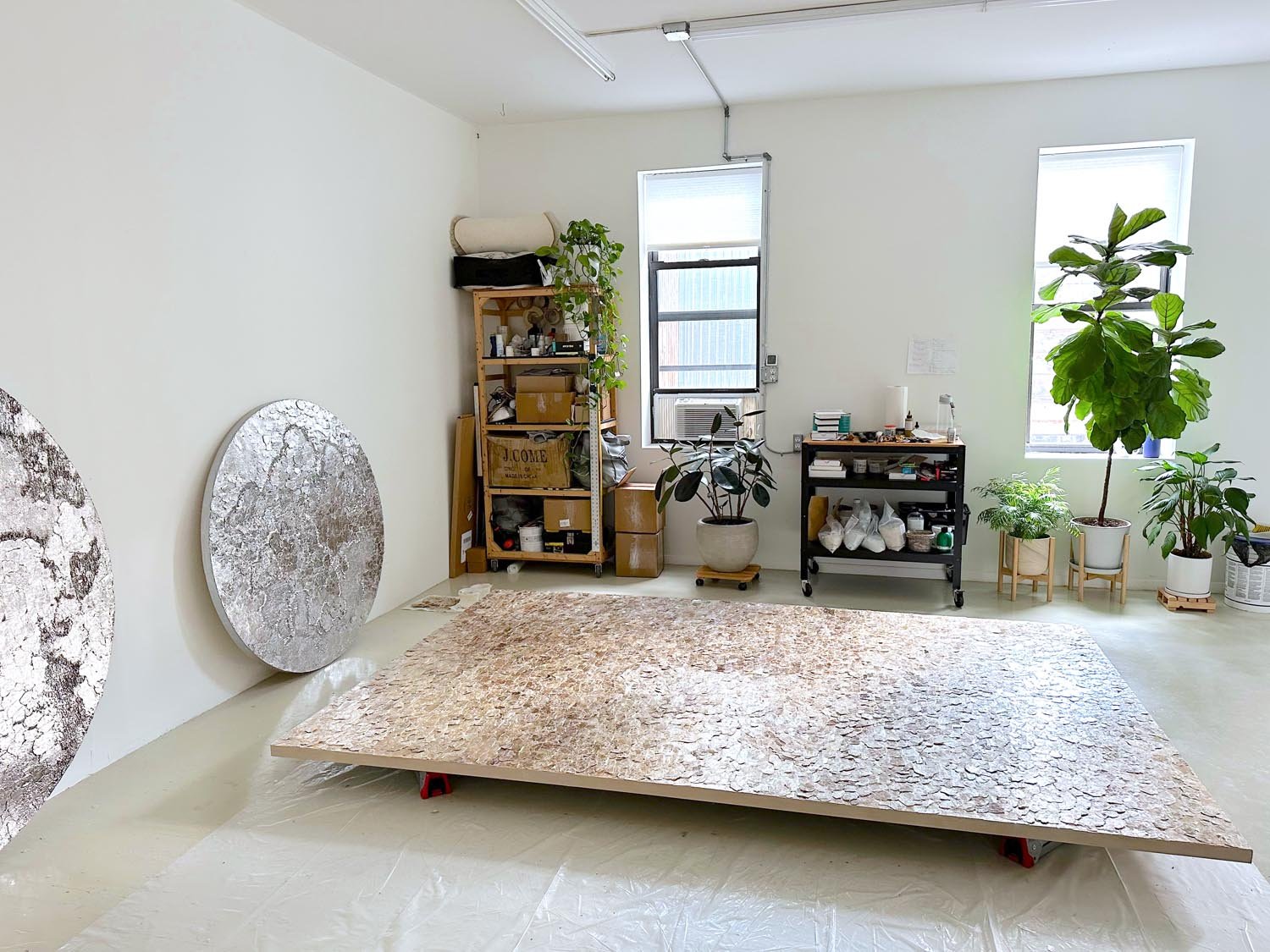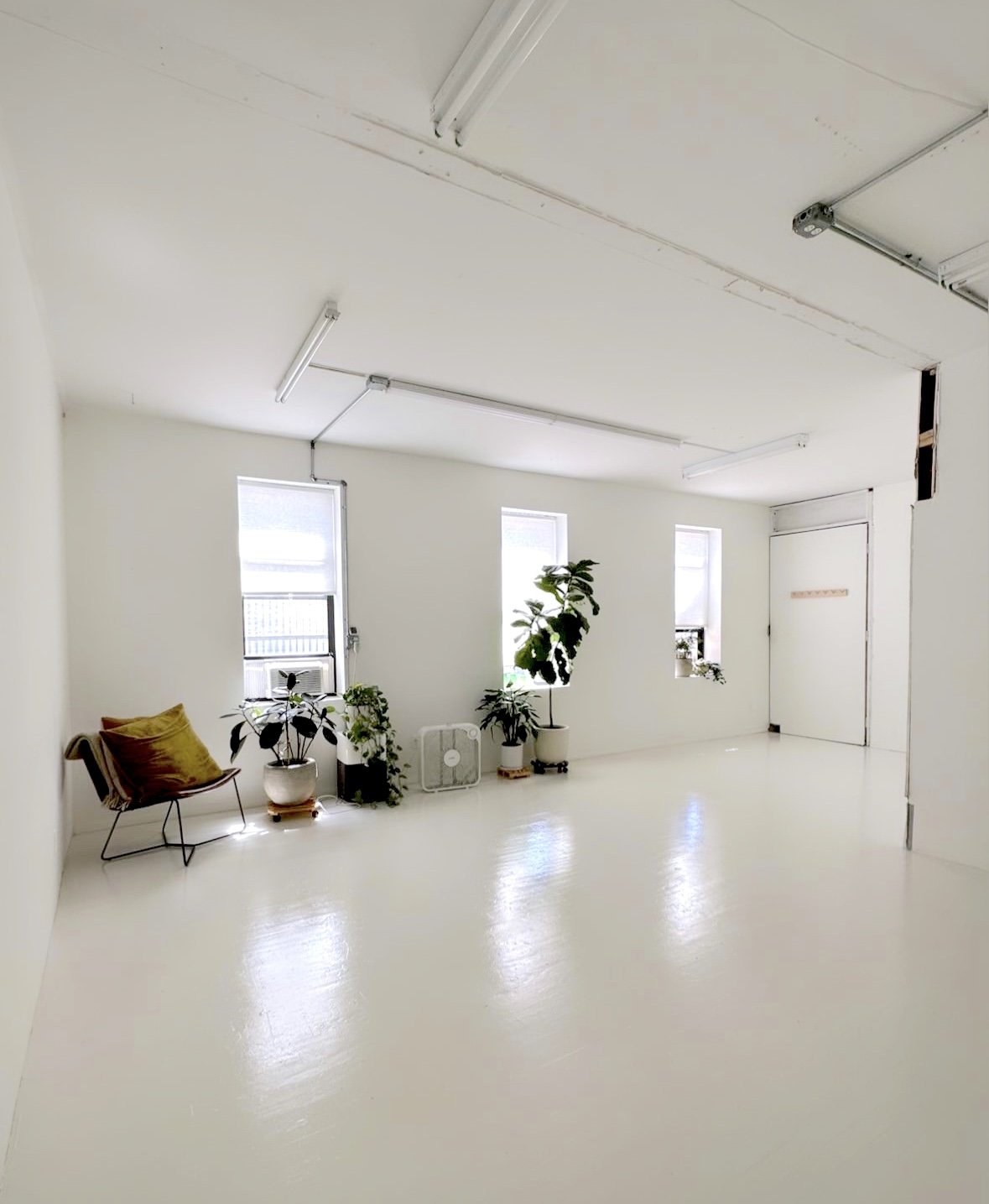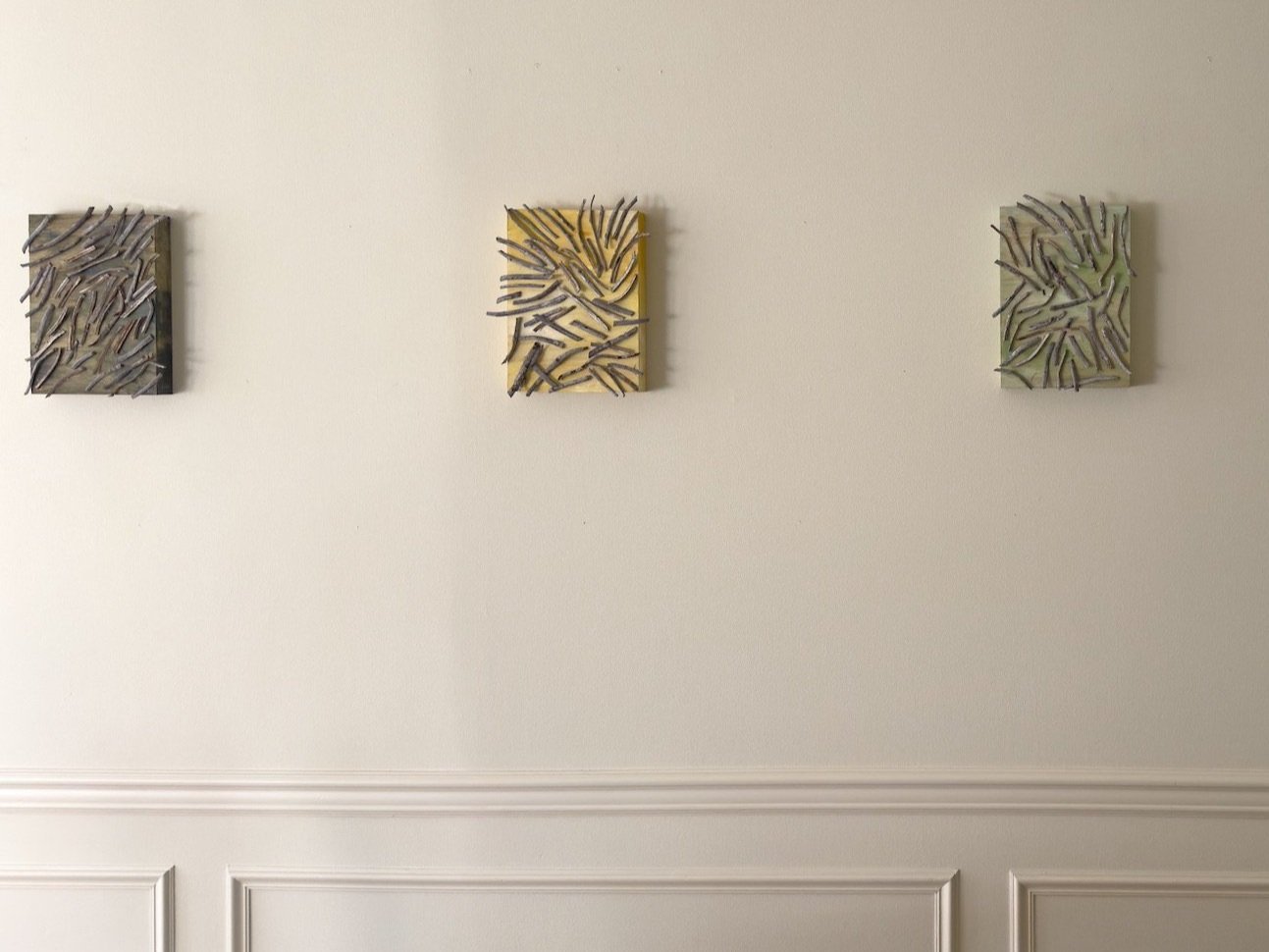STUDIO VISIT: Rosalind Tallmadge
BETWEEN HARMONY AND INVENTION, ROSALIND TALLMADGE FOR THE OPUS ONE ROTUNDA
On the one year anniversary of the vernissage for Opus One’s site-specific commission by Brooklyn-based artist Rosalind Tallmadge, I sat down with the artist to REVISIT the project, her process, and what inspires her.
Learn more about the riveting suite of five monumental paintings she made for us, Between Harmony and Invention, which greets visitors as they enter the storied winery’s rotunda, a limestone-clad space with a central oculus built into an earthen berm by architecture firm Johnson Fain and with interiors by Joan Behnke.
. . . . . . . . .
THE CENTRAL OPUS ONE PANEL, REPRESENTING TERROIR, COMPOSED OF SHAVED MICA cut by hand
"the result is an ephemeral object
such that it anchors the viewer
to the specific space
and moment of time"
AUDRA KIEWIET DE JONGE (AKJ): Rosalind, it is such a pleasure to sit down with you on this momentous occasion and have a conversation about this incredible site-specific work Opus One commissioned for the rotunda of their winery in Napa. Part of what drew me to your work for this particular client is the primacy of process in your work and how that resonates with the cultivation and creation of fine wine; I’d love to dive into our conversation about the project by asking you to tell me more about your process and how you discovered and developed it and how it has changed over the years.
The intricate layers and combinations of organic and synthetic materials are so striking to your work. The finished paintings feel like bas-relief sculptures–being in their presence is to feel their physicality. The process appears to be very physically and mentally engrossing. What is it like to make works like this at such a monumental scale? Do you get lost in the process?
ROSALIND TALLMADGE (RT): I create the paintings on the floor, the first step of the process is creating an “underpainting” composition by manually manipulating the sequin fabric, the result of which forms the basis of the subsequent layers on top. It’s a very physically immediate and intuitive process. There is an element of getting lost in the paintings just due to the sheer scale ratio of the paintings to the body- because it’s such an organic process. The final result arises out of the self generative nature of each decision and layered natural material to create an immersive visual experience.
VIEWS OF THE OPUS ONE COMMISSION IN PROGRESS
AKJ: I feel so glad that there was a fifth niche in the rotunda, as I think the inclusion of the mica piece and its representation of terroir and the human hand in nature’s bounty is so integral to understanding the suite and how it relates to the winery. Would you tell me more about how the mica pieces relate to your sequin paintings in your artistic practice?
RT: I’ve worked with mica as a material in the sequin paintings for the last eight years, but I began exploring this second series of hand cut stone paintings at the height of the pandemic. The process is extremely focused and methodical, and was a way of stripping away and exposing the raw material, which prior to this body of work had always been covered by the gold leaf. It became a therapeutic response to processing the external events happening globally at the time.
The repetitive nature of making this work forced me to focus on the present moment, and the result is an ephemeral object such that it anchors the viewer to the specific space and moment of time in which they’re experiencing the piece. This style connected perfectly to the concept of terroir in terms of the winemaker’s intimate knowledge and cultivation of the landscape in which the wine is created over years and decades.
AKJ: This project has been years in the making, and your artistic output is prolific and surprisingly fast. What do you do to stay inspired and in touch with your creativity inbetween projects?
RT: I’m generally always working on different projects or paintings, either for shows or private commissions. There is definitely an ebb and flow though, and I think every artist needs time to replenish the well of creativity. I’m currently taking the month of August to be away from physically producing studio work, and instead am spending time gathering new materials, thinking about ways to innovate my process with new techniques, reading, taking walks in nature and absorbing my surroundings. This “non-work” time is just as critical as actively producing art.
AKJ: I love how titles in your practice layer in additional insights and invitations for the viewer to ponder the works and be caught up in the act of wondering. What are some themes that are currently inspiring you that you’d like to explore further?
RT: Currently I’m working on expanding the cut stone monochrome works beyond just mica. It’s a jump because it will involve bringing in someone else to help me fabricate the work, so that’s definitely a challenge. I’ve been thinking a lot about how to expand upon the monochrome painting and minimalism using tactile, natural materials that create an optical object. This is something I’ve been thinking a lot about recently in terms of art being a response to how much time we spend on our screens. I want these objects to offer an alternative space that’s completely outside of the digital realm.
AKJ: It is evident in talking to you and reading about your work that you are drawing on a larger art historical and cultural discourse. I think that is so important to the making of culturally rich and meaningful art that builds on what has come before it and defines the art of our time that will endure. Color field painting is an area of particular interest, and I love the almost poetic application of that movement’s philosophy to the seasonality of the wine-making process and the California landscape. Colorfield and otherwise, what artists do you consider to be of particular importance and inspiration to your practice?
RT: Brice Marden, who we recently lost, is a huge influence to me in terms of his philosophical approach to field painting and the connection to the raw earthy material of paint itself. There was an almost spiritual or romantic way in which he talks about monochrome and process based abstraction and what it can offer in the contemporary world. Mary Corse is also another influence– the pieces are so subtle and anti-photographic they really are contingent on physical viewing.
Brice Marden: Elevation, 2018-2019
Mary Corse: Untitled (White Multiband, Horizontal Strokes), 2003
“I want these objects to offer an alternative space
that’s completely outside
of the digital realm.”
AKJ: My job as an art advisor and interior designer centers around connecting people with the art that moves them and enriches their lives and stories. Art/artefact invites people to engage in the thrill of collecting and to feel inspired to live with art in more meaningful ways. How does your home/studio inspire you?
RT: The Ridgewood studio space I spend every day in is hugely influential to my ethos and practice. I’ve sort of created a temple, it’s a completely calm sequestered environment that offers a reprieve from the hectic nature and daily stimuli of living in New York.
RT: I’ve almost become more of a hyper- minimalist with my environment- I have one chair, one table, and my plants I’ve been taking care of for years. This space was also really pivotal to the way I’m thinking about my work now because there are three southern windows with bright filtered light; so now, I never make work in artificial light. It allows me to sit with and experience the work I’m making throughout the day with the changes of the sun, and contributes to this idea that these paintings are not static but environmental and experiential objects.
VIEWS OF THE ARTIST’S STUDIO: Plants, outdoor space, natural light, and a minimalist approach are integral to an environment that cultivates inspired work.
AKJ: What do you collect? What is the most important artwork or object in your personal collection? Please share the story behind it.
RT: Since I live in a really small apartment (-400 sq. ft) I have to be very particular about the use of space. I mainly collect abstract paintings by friends that I respond to or want to support. This sounds counterintuitive, but I’m actually not overly precious about the objects in my environment. I think this is because I spend all day looking at art, when I come home it’s kind of a visual break for me haha. Probably my favorite object is a shaped copper mirror designed by my friend Nina Cho, that I did a trade with for a painting. It’s very simple but specific and so beautifully made, it completely elevates the space around it.
. . . . . . . . .
Interested in TALLMADGE’S work OR WONDERING HOW TO COMMISSION ARTWORK FOR AN ARCHITECTURE OR HOSPITALITY PROJECT?
We specialize in connecting the perfect piece with it’s environment, making the art and the architecture truly sing. Feel welcome to contact Audra with questions by email at audra@artartefact.com.
Learn more about our project for Opus One.
Rosalind Tallmadge with L’hiver, a 10-foot tall panel from the suite of paintings commissioned for Opus One
AUDRA KIEWIET DE JONGE IN FRONT OF A WORK BY ROSALIND TALLMADGE COMMISSIONED FOR THE OPUS ONE ROTUNDA. PHOTOGRAPH BY BORIS ZHARKOV.
Art/artefact is a nationally recognized art advisory and interior design practice founded by Audra Kiewiet de Jonge and known for placing a great collection at the heart of every interior.
Formally trained as a painter and an art historian, Audra’s modern sensibility is informed by her historical perspective—bringing art and objects into context and conversation with the way we live today.
Working with private and corporate clients nationally, our interiors are meticulously curated and expertly built to be high on artistry, but not on pretense.


















